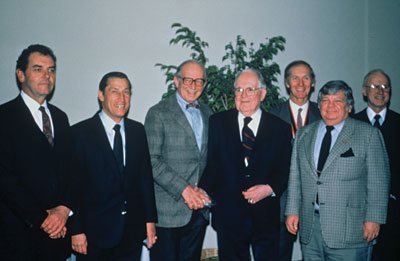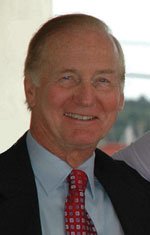AOSSM provided a foundation for the sports medicine subspecialty to thrive
The AOSSM led to the expansion and recognition of the sports medicine specialty in the United States.
Click Here to Manage Email Alerts
In the 1960s, the phrase “sports medicine” was not mentioned in medical schools or residency programs. Faculty discussed the treatment of knee and shoulder injuries in athletes but, as an academic specialty, sports medicine did not exist.
In 1972, 75 orthopedic surgeons established the American Orthopaedic Society for Sports Medicine (AOSSM). Nearly 40 years later, sports medicine is the most popular fellowship in orthopedics, with one third of all orthopedic residents entering into a sports medicine fellowship program, according to AOSSM President Robert A. Stanton, MD.
“Sports medicine has existed since the beginning of time. People have always danced, participated in sports, and got hurt, and someone took care of them — regardless of culture or society,” Arthur L. Boland Jr., MD, chair of the AOSSM History Committee and past president of the society from 1995 to 1996, said. “But in North America, it wasn’t part of a core curriculum for medical students or residents.”
|
Images: AOSSM |
From committee to society
In 1964, the American Academy of Orthopaedic Surgeons (AAOS) created a Committee on Sports Medicine. However, after difficulty getting papers on sports medicine included in the annual meeting program, several orthopedists, including Donald O’Donoghue, MD, chairman of the committee, identified the need for a smaller organization that would focus on studying the diagnosis and treatment of common athletic injuries, according to founding member H. Royer Collins, MD.
“There was a feeling that [sports medicine] was looked down upon by the ‘powers that be’ in orthopedics,” Robert E. Leach, MD, editor of the American Journal of Sports Medicine from 1989 to 2001 and president of the journal’s Board of Trustees from 1989 to 1991, told Orthopedics Today. “When [sports medicine doctors] tried to get their papers in the programs, they were often refused. When they tried to get papers published, they were rarely accepted.”
In December 1971, O’Donoghue invited 75 orthopedic surgeons, including Jack Hughston, MD, Joseph Godfrey, MD, Joe King, MD, James A. Nicholas, MD, and Leslie M. Bodnar, MD, to the initial meeting of the AOSSM to be held January 1972 in Washington, D.C. In January 1973, O’Donoghue presided over the first AOSSM meeting, which was held in conjunction with the AAOS annual meeting in Las Vegas. The initial membership of 75 surgeons has grown to 2,800, and approximately 200 new members are accepted each year.
According to Boland, the goals of AOSSM are essentially the same today as they were during that first meeting: educational growth, a forum for debate and discussion, and eventually, clinical research in sports medicine.
“[We] felt that there were specific injuries that occurred more often in the athletic population, and we, as orthopedic surgeons, at the time really did not know how to take care of [these patients] or in some cases even diagnose the problems they had,” Collins said. “It was a field we felt was a little bit neglected and overlooked.”
|
|
Securing a journal
Another important step in sports medicine took place in 1972 with the establishment of the Journal of Sports Medicine, now the American Journal of Sports Medicine (AJSM). William Sinton, MD, and a local publisher, Benjamin Goode, are credited with starting the journal. In 1976, AOSSM bought the journal from Sinton and Goode for $50,000 with a private loan secured by Bodnar. Hughston was appointed editor and, in 1979, AOSSM appointed a Board of Trustees of the journal, with Leach serving as president.
Williams and Wilkins published American Journal of Sports Medicine until 1986, when the journal became self-published. Leach served as editor from 1989 until 2001. “We became progressively more academic, without losing the fact that we were a clinical society,” Leach said. “In 1996, the society board and journal board met, and the relationship between the society and the board became even closer.”
In 2000, Leach met his goal of getting the journal online.
“I wanted [the journal] to become more academic, I wanted to get a younger reviewing board … I wanted to get people from all over the world, and I wanted to get us online,” Leach said. “We were able to accomplish that, and all throughout this, the people within sports medicine were very supportive.”
Highlights in AOSSM history
Other milestones in AOSSM’s history include the addition of a second journal, Sports Health, 3 years ago; the hiring of Tom Nelson, the first executive director, in the late 1970s; and the hiring of a full-time executive director, Irvin E. Bomberger, in 1999, according to Stanton.
|
|
“The strength of an organization is not just in the members, but it’s the support system too,” Boland said. “Our support system is invaluable to the way this society has grown.”
In 1979 to 1980, AOSSM became associated with the U.S. Olympic Committee, thanks to the efforts of Marcus Stewart, MD, according to Leach. “The Olympics have certainly an appeal to everybody, and the fact that the AOSSM was involved with them … showed that sports medicine was broadening all along,” he said. “People in a variety of areas — whether it was a professional tennis tournament or a professional football team — were looking to sports medicine specialists and they were getting success.”
In the 1980s, AOSSM worked with the American Board of Orthopaedic Surgery (ABOS) to certify sports medicine fellowships. The AOSSM has also established an international fellowship program, due to the efforts of John A. Feagin Jr., MD. This program now reaches to Europe, the Asia-Pacific and South America.
Additionally, about 3 years ago, AOSSM worked with the Arthroscopy Association of North America to set up a new fellowship matching system. Five years ago, the society’s subspecialty certification — a work in progress for about 15 years — was accepted.
“Now our fellows and anyone who wishes can be subspecialty certified in the field of orthopedic sports medicine, and that’s a real milestone in the history of our society,” Stanton said.
The AOSSM also created a pathway soley focused on sports medicine that allows orthopedic surgeons in the specialty to gain recertification.
New programs and challenges
As the society changes, its main challenge will be maintaining all of its programs, Boland said. For example, traveling to meetings for continuing education is becoming more costly, so AOSSM is trying to find ways to provide these courses in a cost-effective manner, such as online programs and psychomotor skills training.
|
|
Another challenge is educating the public about sports medicine issues, such as little league shoulder and elbow problems and the importance of lifelong participation in running or exercise programs, according to Boland.
“It’s always been a bit of a struggle to get that out in an effective way, but also in a way that doesn’t appear to be tooting our own horn … or interfering with what other people might be doing,” he said.
Similarly, as American society becomes more athletic, the organization is challenged to educate the public on sports injury prevention. According to Leach, James R. Andrews, MD, past AOSSM president from 2009 to 2010, involved the society in the development of the Sports Trauma and Overuse Protection campaign, along with AAOS, the American Academy of Pediatrics and other societies, to provide sports injury prevention tips for young athletes.
“We have to understand that a lot of the things we use for high-quality athletes we now use for … people who may not consider themselves athletes, but still have a strained elbow from working or a sprained ankle from taking a long walk,” Leach said. “A lot that we’ve done for athletes is in fact applicable to people who get some of the same injuries.”
Like all those involved in health care, AOSSM is also navigating a new health care environment.
“Our goal is to stay a world leader in orthopedic sports medicine education, research, communication and fellowship,” Stanton said.
As in the past, Leach said that goal will likely be met through the support of the society’s members.
“People in sports medicine as a group are very supportive of the specialty and of each other,” Leach said. “One of the strong points of the society and of the specialty is that people seem to get along. People really seem to try to push the specialty … and are just interested in doing the best for sports medicine.” – by Tina DiMarcantonio

- Arthur L. Boland Jr., MD, can be reached at Harvard University, Department of Athletics, Murr Center, 65 North Harvard St., Boston, MA 02163; 617-495-2200; email: aboland@partners.org.
- H. Royer Collins, MD, can be reached at the Institute for Bone and Joint Disorders, 2122 E Highland Ave., #300, Phoenix, AZ 85016; 602-553-3113; email: hrcollinsaz@aol.com.
- Robert E. Leach, MD, can be reached at 40 Rockport Rd., Weston, MA 02493; email: releachrock@gmail.com.
- Robert A. Stanton, MD, can be reached at Orthopaedic Specialty Group PC, 75 Kings Highway Cutoff, 2nd Floor, Fairfield, CT 06824; 877-926-7474; email: rstanton@osgpc.com.




